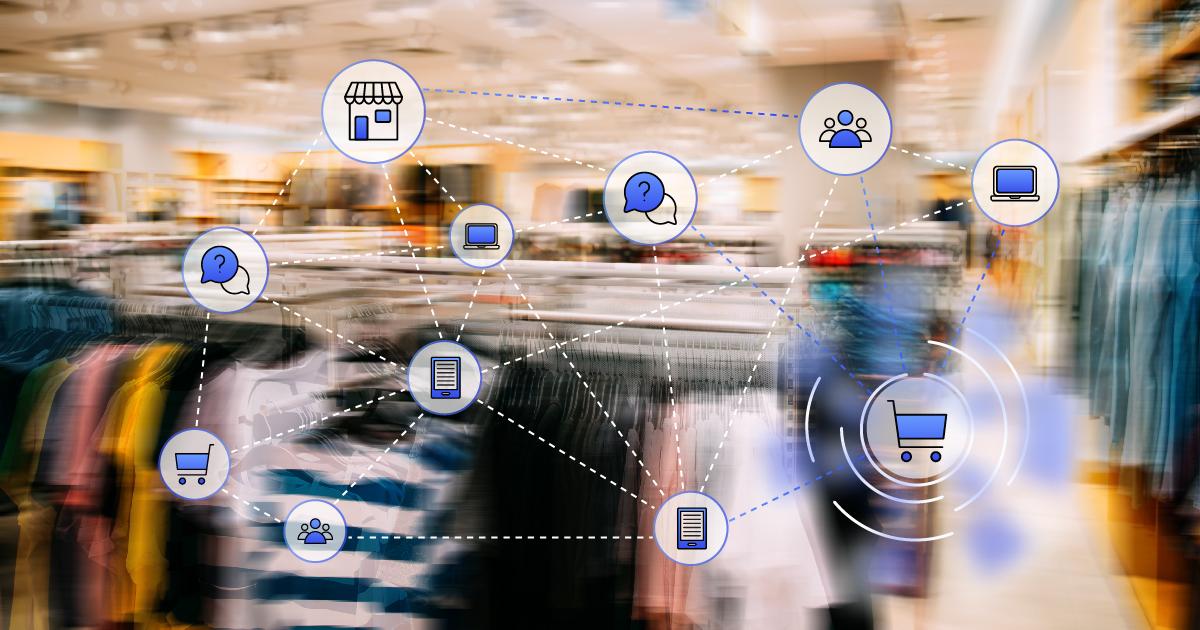
Why Data and Omnichannel Success Go Hand in Hand
Contents
Although the terms “multichannel” and “omnichannel” are often used interchangeably, many people don’t understand the crucial differentiator: Omnichannel retailers provide a unified customer experience across their in-store and online sales channels, bridging the consumer journey between digital and physical environments seamlessly. Their secret? These savvy sellers constantly tap into data to inform their next moves.
It’s no easy feat, and even retailers that have successfully scaled into omnichannel operations often find themselves falling flat in two key areas. The first is that they neglect to build internal processes that align their business goals across channels—instead treating various channels like separate organizations with different policies and operations. Secondly, they also fail to realize a way to accurately measure business success. Spoiler alert: Both challenges stem from haphazardly trying to piece together data from various sources, and losing critical information as a result.

The bad news is that data loss (and, more importantly, wasted money) can be a disastrous lesson to learn for businesses looking to scale. The good news? Integrating your data will help you avoid this debacle. Here’s how.
The Role of Data in Producing an Omnichannel Experience
Let’s face it, crawling through the dark without a flashlight or any contextual clues to guide you is an inefficient and ultimately ineffective way of reaching a specific destination. The same concept applies when growing your business: Without data lighting the way, it’s impossible to know whether you’re moving in the right direction or heading toward potential roadblocks.
There are two main data sources for producing a viable omnichannel experience, says Peter Eastvold, QuickBooks Point of Sale expert and owner of BlackRock Business: sales channels and customer touchpoints.
“You want to have your systems delivering messaging and information—including your customers’ data that is complete and similar every time, whether they order online or in person,” Eastvold says. “If you have their data, how does that touch happen with them, and how does a follow-up happen afterward?”
At the same time, omnichannel retailers are managing multiple storefronts, some digital and some brick-and-mortar locations. “You need to maintain the sales data, and the synchronization of everything, [including] the order flow and the process in which you receive orders from different people on different platforms,” Eastvold explains.
Providing your customers with an integrated and unified customer experience can help grow your business and keep customers coming back.
No wonder chaos ensues for many businesses attempting omnichannel without first aggregating their data.
What Makes Omnichannel Data Collection Challenging
Whether you’re new to omnichannel or have been in the game for a while, getting a clean, actionable, centralized source of data can be challenging. Why is that? Because it can be a trying, costly goal set up against a constantly moving target.
“It takes magic,” Eastvold laughs. “A lot of times it [requires] custom programming, which is obviously outside of most people’s knowledge and financial realm. It could cost 10, 20, 50 thousand dollars to make it all happen. That’s why it’s challenging people—they don’t know what the options are, and they don’t have either the knowledge or the money to make it happen themselves.”
Most sales channels (think marketplaces like Amazon and eBay, online stores like Shopify and BigCommerce, and your POS system at your physical store) offer some form of performance analytics, although some reports are more limited than others. And piecing them together by hand can prove disastrous. Eastvold says many of the businesses he works with are still using antiquated data collection methods like Excel spreadsheets that don’t sync up. The main drawback? Important data points get lost when aggregating all the reports, leading to a whole host of problems.
The Dangers of Lost Omnichannel Data
So if leveraging data is the secret to omnichannel success, it’s safe to say a guaranteed way to crash and burn is to lose track of that data.
“If you don’t have a system that combines [your data in one location], then you drop the ball without even knowing it,” Eastvold says. In the earlier stages of his own business, the ecommerce advisor says he missed leads from prospective clients because his systems weren’t integrated at the time. The result? Weeks passed before he realized these businesses had tried to contact him.
With the average ecommerce conversion rate standing at 2.86%, retailers—especially those trying to scale into omnichannel—can’t afford to miss a single opportunity. They have to consider data sources like website traffic, rewards program performance, cart abandonment rates…the list goes on and on. But if all that information isn’t working together to inform a larger total business strategy, growth will happen in fits and starts, if at all.

To put it mildly, there are some serious pitfalls of data losses. Here they are in a nutshell:
- Lack of success measurements: Think you can really see how well your business is doing with missing data? Think again. You need every piece to see the whole puzzle, and full visibility into your performance data to determine whether you’re seeing success.
- Limited profitability insights: In the same vein, you need to see the true operational costs from all your sales channels before proclaiming your business is profitable. A perfect example? Gaining granular data about your marketplace fees and expenses to determine product profit margins.
- Clunky customer experience. Let’s say a customer places an online order but needs to make an exchange. If your brick-and-mortar location doesn’t offer online exchanges, that customer probably won’t shop with you again because the interrupted experience is frustrating.
- No long-term viability. You can’t crawl through the dark forever. Without data to guide you, it’s nearly impossible to set measurable business goals or create a plan to reach them. And if your customers are unhappy? You can kiss your business goodbye.
Even if you’re not heading into a growth mission totally blind, you’re taking real risks by not considering the must-haves for scaling into omnichannel.

The 4 Things Retailers Need to Scale into Omnichannel
Savvy businesses are rapidly embracing omnichannel commerce to meet consumer demands and capitalize on shoppers who are more engaged, show increased loyalty, and spend more. Unfortunately, offering a seamless customer experience across multiple physical and digital channels is not for the faint of heart. Retailers need a few things to scale into omnichannel: discomfort, customer profiles, streamlined branding, and a tech stack that enables it all.
We say “discomfort” because retailers have to get comfortable with being uncomfortable. Here’s the tough truth: Your business has to change if you’re going to make omnichannel work. The operational habits you’ve developed between channels will have to be amended so you run every channel the same way. There will be growing pains, but in the long run your unified customer experience will be worth it.
More food for thought: As you align your sales channels, consider the persona behind your ideal customer. Developing an ideal customer profile (ICP) is the first step toward creating the perfect omnichannel experience for the people who are buying your products. Think about who’s purchasing where, the patterns in those purchases, and the steps of the omnichannel customer journey.

But the customer experience isn’t the only part of your business that needs alignment. Peter Eastvold recommends creating a true brand by streamlining your language, aesthetics, and personality. “It’d be kind of funny to get stylish emails and then go someplace in person and it looks like a warehouse,” he explains.
To tie it all together, retailers looking to sell omnichannel need technology that powers an aggregated data set, offers real-time analytics, and seamlessly syncs all channels. The fact is, you need to not only see your business KPIs across the entire omnichannel operation, but also drill down to the granular performance by channel. Otherwise, your data aggregation will be manual and time consuming—making you reactive rather than proactive.
While growing and moving to an omnichannel experience, don’t let accounting get in the way of the success you’re having.
The prospect of scaling into an omnichannel operation can be hugely intimidating, but retailers who let their data lead the way will see it in their customer satisfaction and bottom line.
By guest contributor Taylor Knauf
Monika Tripathi is a Sales Director at Webgility. She excels in driving revenue growth, building high-performing teams, and developing strategic partnerships across global markets.




.png?width=56&height=56&name=image%20(2).png) Monika Tripathi
Monika Tripathi


